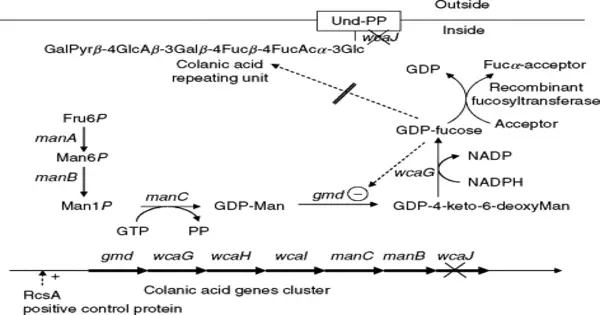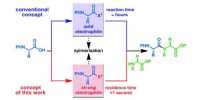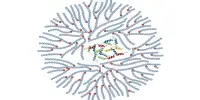Colanic acid is a complex extracellular polysaccharide (EPS) generated by bacteria, namely those in the Enterobacteriaceae family, which includes organisms such as E. coli and Salmonella. It is an exopolysaccharide that bacteria in the Enterobacteriaceae family produce. It is secreted by the cell to create a protective bacterial capsule and helps to produce biofilms. This acid is an important component of the bacterial cell membrane and plays a variety of important roles in bacterial physiology and interactions with their surroundings.
Structure
Colanic acid is a polyanionic heteropolysaccharide with hexasaccharide repeating units that includes glucose, fucose, galactose, and glucuronic acid. Attached to these sugar molecules are O-acetyl groups and pyruvate side chains. It creates a protective capsule around cells, mainly those of the Enterobacteriaceae family.
Colanic acid’s high viscosity is due to its high molecular weight and branching structure, while the carboxylic acid groups in its structure are the key contributors to its acidity. When injected intraperitoneally into mice, it is regarded as slightly hazardous, and its effect on mammals is comparable to that of modest dosages of endotoxin, which can produce diarrhea and malaise.
Colonies of E. coli that produce colanic acid are said to be carcinogenic because they are larger, smoother, and more opaque than those that do not. Colanic acid is amorphous, colorless, and fibrous, and it is water-soluble as well as soluble in dilute salt solutions.
Some key functions and properties of colanic acid include:
- Capsular Polysaccharide: It has the ability to behave as a capsular polysaccharide, forming a protective covering around the bacterial cell. This capsule can protect the bacterium from the host’s immune system and antimicrobial agents, hence increasing bacterial pathogenicity.
- Biofilm Formation: It helps bacteria develop biofilms, which are complex structures that bacteria use to cling to surfaces and protect themselves from environmental stress and immunological reactions. Biofilms are found in many bacterial infectins.
- Stress Response: Bacteria can produce colanic acid in response to environmental stresses, such as changes in temperature, pH, and osmolarity. It helps protect the bacterium from adverse conditions.
- Adherence and Colonization: It can promote bacterial adherence to surfaces, which is essential for colonization in various niches, including the human gastrointestinal tract. This property can contribute to bacterial virulence.
- Antibiotic Resistance: The production of colanic acid has been associated with increased antibiotic resistance in some bacterial species.
Function
Under stressful situations, colanic acid’s major purpose is to produce a protective slimy capsule around the cell surface, increasing the cell’s chances of survival. Desiccation, oxidative stress, and low pH can all be signs of a stressful environment. Colonic acid expression in E. coli has been shown to be essential for the formation of typical E. coli biofilm architecture.
Colanic acid production is increased in biofilms, where acetylation is important in altering structural conformation as well as physical and chemical characteristics. Colanic acid is required for biofilm development in E. coli. It does not, however, improve bacterial adherence; rather, it prevents the formation of particular binding between bacteria and the underlying substrate.















